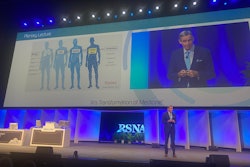
Yes, artificial intelligence (AI) will likely be a useful adjunct for radiologists and increase their productivity. But AI's greatest effect may be to usher in a new role for radiologists as information managers, according to an article published online February 2 in the Journal of the American College of Radiology.
Thanks to AI's ability to integrate a wide variety of clinical information from a range of sources, physicians will be needed to explain imaging findings in the context of the patient's comprehensive dataset, including demographic, genomic, anatomic, and physiological features, wrote Dr. Saurabh Jha from the University of Pennsylvania and Dr. Eric Topol from the Scripps Translational Science Institute in La Jolla, CA.
"It will be a missed opportunity for radiologists if this responsibility falls entirely on referring clinicians," they wrote.
While AI will be the "information churner" in the future, radiologists will have the opportunity to interact directly with the software, referring clinicians, and even occasionally with patients.
"The added value of radiologists to patients will be in both their empathy and wisdom," they wrote. "Future radiology reports that describe imaging findings without contextualization with other sources of information will be like using a map that describes latitude or longitude, but not both."
A new mindset
To prepare for this new world, radiologists first need to acknowledge the future and then change their mindsets, according to the authors. Radiologists should integrate other sources of data such as patient history and laboratory tests during interpretations. In addition, radiologists might also consider performing joint reads with pathologists, or even embedding themselves in areas such as the intensive care unit or the emergency department.
"Radiologists should refrain from rendering an interpretation of advanced imaging without other sources of information; these sources can be actively sought, strategically demanded, or expeditiously extracted from electronic health records," they wrote.
In addition, radiologists should get involved in managing imaging utilization. With the help of clinical decision support, they should offer advice to clinicians on the appropriateness of the imaging study -- before it's performed as well as after it's been interpreted.
"This, too, is information management where radiologists function as a doctor's doctor," Jha and Topol wrote. "The decision to pursue an imaging test, and the choice of the right diagnostic test, would best be shared by patient, clinician, and the radiologist."
They noted, though, that determining imaging appropriateness in the future is likely to be very nuanced and cognitively challenging. To free up the time needed to perform information management, radiologists should recognize the elements of their job that can be automated.
"Until AI is able and willing, radiologists should outsource tasks such as interpretation of portable radiographs to lower-cost providers, such as technologists," they wrote.
Jha and Topol believe the biggest challenge will be the need for pedagogic change in radiology. If AI in the future interprets studies such as head CT scans, portable chest radiographs, and CT pulmonary embolism studies, residents and attending physicians need to read fewer of these studies. And residents won't need to be as good as their predecessors at interpreting these cases.
"Time spent in various subsections, such as neuroradiology and thoracic and cardiovascular imaging, can be reduced," the authors wrote. "In the time freed, residents can learn about newer sources of information -- how they are acquired and how they may be integrated."
Renaissance radiologists
The authors believe it will take a few renaissance radiologists to define the new paradigm by adopting AI, building its expertise, and giving AI graded responsibility -- while building their own expertise in other information domains.
"For example, these radiologists can start by conducting multi-informational, multidisciplinary meetings, bringing to the table their new expertise," the authors wrote. "Later, radiologists can migrate to the consulting room of clinicians for joint consultations with patients. We emphasize 'joint consultations' because for the greatest impact, radiologists, or information specialists, must be seen by clinicians as their natural allies, who intend to complement, not substitute, their work."
Practicing radiologists -- in academia or private practice -- must initiate this change toward information management, according to Jha and Topol.
"Ideally, a farsighted academic chairperson will nurture maverick radiologists and, one day, offer a new residency specializing in medical information management," they wrote. "We believe the change must start now for it to realize fruition 15 years from now."
Radiologists must also reject the false dichotomy that only AI or radiologists can survive in the future.
"Healthcare has a space for both radiologists and AI," they wrote. "It is, however, radiologists who must adapt to their new partners."




















